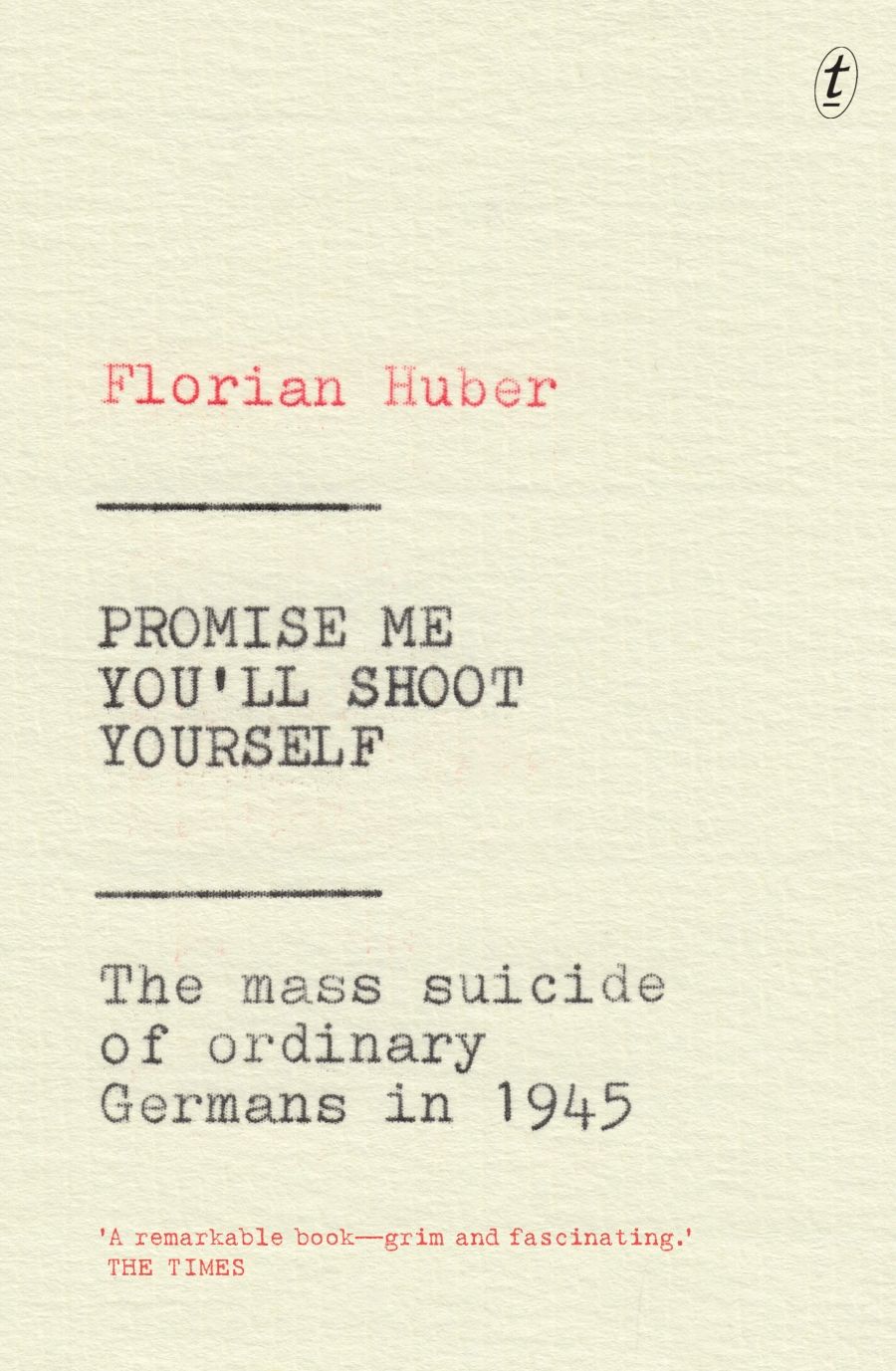
- Free Article: No
- Contents Category: History
- Review Article: Yes
- Online Only: No
- Custom Highlight Text:
Everyone knows about the final days of Adolf Hitler – his abject suicide in a clammy Berlin bunker. Many prominent Nazis followed suit, including the master propagandist Joseph Goebbels, who broadcast messages to the public espousing the virtue of death over defeat. His wife, Magdalena, wrote ...
- Grid Image (300px * 250px):

- Alt Tag (Grid Image): Promise Me You’ll Shoot Yourself
- Book 1 Title: Promise Me You’ll Shoot Yourself
- Book 1 Subtitle: The mass suicides of ordinary Germans in 1945
- Book 1 Biblio: Text Publishing, $32.99 pb, 224 pp, 9781925773699
Huber makes artful use of eyewitness accounts – diaries, letters, memoirs – to construct a fast-paced narrative and a ‘view from below’. Medical student Lotte-Lore Martens observed the smoking town, its doomsday scenery:
The meadows by the river, resplendent in their spring finery, were edged, like the borders of a dress, with about 1.5–2 metres of baby’s clothes and other garments – expensive frocks and furs in particular – and identity papers and passports. Money, too – a lot of money – but nobody stooped to pick it up; it seemed to us worthless.
Huber’s primary interest is psychological. In Demmin as elsewhere, he argues, Germans saw no way out of the horrors they anticipated: the vengeful Russians, but also a seemingly unbearable transition to a world where Germans were ruled (and judged) by hated enemies. There were far fewer suicides in western regions, but Huber insists that the nationwide picture reflected the same disorientation and terror. ‘Urgency, contagion, fear,’ he writes. ‘Demmin was everywhere.’
At times, Huber seems overly eager to ascribe a sense of moral reawakening. When accounts report a loss of faith, it is not certain they have realised the wrongness of Nazi ideology: they might just be disappointed that a righteous war was failing. An illustrative sequence explores the diary of Johannes Theinert, a teacher at a Nazi school, and his wife. When a former pupil informs them about the extent of German atrocities, they realise that the advancing Russians have, in Huber’s words, ‘every reason to feel hatred and anger towards the Germans’. The Theinerts soon decide to kill themselves. Huber speculates that this was caused by a realisation of their own complicity, but here is his supporting quote from Frau Theinert: ‘How lovely the future could be, if only – yes, if only – grim reality hadn’t destroyed all our dreams of life after the war.’ It sounds more like Magdalena Goebbels than sincere moral repentance. The notion of self-accusing suicides might be reassuring – everyday civilians waking up and beginning to prosecute the past – but the evidence is unconvincing.
The book’s German subtitle is Der Untergang der kleinen Leute. The beginning, Der Untergang (‘downfall’), evokes the canonical film about Hitler’s suicide, while kleine Leute (‘little people’) is an idiom that can mean ‘ordinary folks’, but here it seems to emphasise civilians’ comparative powerlessness. When narrating the ruins of 1945, Huber’s characters seem helpless – but we do not see their previous years of accelerating hatred, petty compromises, cruelly misdirected enthusiasms. (Herr Theinert’s career indoctrinating children does not feature.) The dangerous idea that Nazi crimes were perpetrated by an influential minority, separate from good (if naïve) everyday Germans, was a popular reactionary myth right after the war. No doubt many eyewitnesses did feel powerless – plenty will have wanted to emphasise their impotence in hindsight – but Huber seems unduly ready to take them at their word.
In the book’s second section, an emotional history of the Nazi period, Huber argues that Germans spent twelve years in an ‘intoxicated’ state of moral avoidance. What remained for the defeated was nothing but guilt, fear, and ‘despair at the emptiness that now faced them’: many chose death instead. This historical background, though somewhat incongruous, provides essential context by including true believers alongside compromisers, registering the agency many Germans did have, and discussing the widespread postwar victim complex.
These mass suicides have been relatively understudied, partly because of taboos around the discussion of German wartime suffering. Progressive Germans have largely shied away from anything that might encourage myths of German victimisation. Yet recent decades have seen a renewed mainstream interest in these topics, notably W.G. Sebald’s essay on Allied bombing and Günter Grass’s novella Crabwalk (2002), which considered the risks of leaving such ‘unploughed fields’ of collective trauma to right-wingers.
Suicides occupy a difficult status, resistant to categories of victim and perpetrator. Huber attempts to avoid the temptations of victimhood, and he generally succeeds – especially in the book’s broader second half. Still, the emotional force of the book lies with those helpless civilians in the horrorscape of Demmin. Huber’s narration, due to its force and narrow focus, threatens to fall into old traps.
Huber is passionate about giving voice to these people overtaken by history. One chapter ends with Frau Theinert’s final diary entry: ‘Who will think of us, who will know how we ended?’ The price of Huber’s devotion to individual narratives is that he risks repeating their delusions and elisions – this book pays alarmingly scant attention to the Nazi regime’s victims. Where are the dissidents, the Jews, the Romani, the homosexual or disabled people? These were all ordinary Germans as well – until the Germans decided they weren’t.


Comments powered by CComment